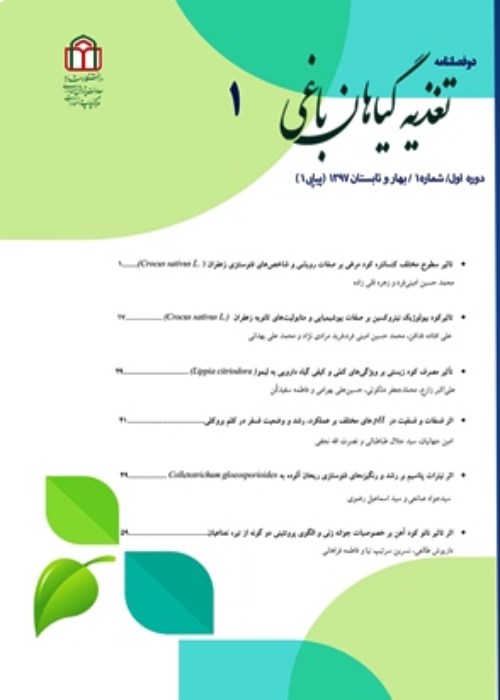Effect of foliar application of some micronutrients on growth, biomass and morpho-physiological characteristics of basil in three different cultivation systems
Basil (Ocimum basilicum) is an annual plant of the Labiateae family and native to tropical regions. The plant is most commonly used fresh in recipes. Many diverse activities such as antifungal, antibacterial, anticancer, antioxidant, antidiabetic, antiinflammatory, antiarthritis and anti-stress have also been observed in O. basilicum (Shahrajabian et al., 2020(. Nutrient deficiencies in soil culture crops and impossibility of appropriate managements are the important reasons for low crop productivity in farm. Micronutrients (e.g. iron, boron, manganese, zinc and copper) are required in very small amounts by the plant, but play an iprominent role in plant growth and development (Nayak et al, 2020). In hydroponic system, the yield and quality of horticultural plants can be significantly improved compared to conventional soil culture (Putra and Yuliando,2015). Development of new agricultural systems for horticultural crop cultivation is necessary. The present study was conducted to compare the growth, biomass and morpho-physiological characteristics of Iranian purple basil in farm and greenhouse cultivation (soil and hydroponics cultivaion). In addition, the effect of foliar application of five micronutrients on the plant was investigated.
In this research, three cultivation systemes (conventional soil culture in farm, soil pot culture in greenhouse and hydroponics cultivaion) was compared. The experiment was done in the research farm and greenhouse of the Faculty of Agriculture and Natural Resources of Lorestan University in 2019. In all cultivation systems, a randomized complete block design with three replications was performed. Foliar application of micronutrients was applied in six levels (control, foliar application of iron, zinc, copper, manganese and boron). Iron sulfate, zinc sulfate, copper sulfate, manganese sulfate, and boric acid were used as micronutrient sources. In studied cultivation systems, micronutrients wewe sprayed three times (eraly vegegative stage, late vegegative stage and early flowering stage).
Resuls showed that plants grown in the field had higher crown diameter, number of nodes, number of leaves, stem dry weight, number of lateral branches and carotenoid content. However, cultivation in hydroponic system led to growing plants with higher plant height, internode length, plant fresh weight, plant dry weight, leaf area, chlorophyll content, stomatal conductivity and photosynthesis rate. Generally, basil plants had shown the highest growth and yield in hydroponic system, followed by greenhouse soil culture. In comparison between foliar application of nutrients, the results showed that the application of zinc resulted in obtaining the highest leaf dry weight, but there was no significant difference with the treatment by application of copper, iron and boron. However, foliar application of nutrients led to different results in each cultivation system. In field cultivation, maximum of plant height, internode length, crown diameter, number of lateral branches, leaf area and stem dry weight were observed in iron spraying. In greenhouse soil cultivation, the highest plant height and internode length were obtained using boron and iron application. In hydroponic system, the highest plant height and internode length was obtained by application of boron. In field cultivation and soil cultivation in greenhouse, the highest photosynthesis rate and stomatal conductivity was observed in iron spraying treatment. In hydroponic culture, however, the photosynthesis rate and stomatal conductivity was higher in copper and iron foliar application in compare to other nutrients.
In the present study, basil plants grew up in the fields not only had shown lower growth and yield, but also had rough leaves that lower their edible quality as vegetable. While, leaf to stem ratio and freshness of leaf tissue was the highest in the hydroponic system. The response of plants to the micronutrients application was different in each cultivation system. Application of zinc in all three cultivation systems resulted in the highest leaf dry weight. In the field cultivation, the best results were obtained by foliar application of iron. In soil greenhouse cultivation, the use of iron and boron had more positive effects on plants.
Hydroponics , iron , zinc , Manganese , Boron
-
The Effect of Pre-Harvest Chitosan and Nano-Chitosan Application on The Shelf Life and Quality of Fresh Pistachio (Pistacia vera L. Cv. 'Ahmad-Aghaei')
Shirin Taghipour, *, Hossein Hokmabadi
Journal of Horticultural Science and Technology, -
The Effect of Silver Nanoparticles Application on the Physico-Biochemical Responses of French Marigold (Tagetes patula L.) Under Salinity Stress conditions
Khatoun Behzad, Abdollah Ehtesham Nia *, Mohamadreza Raji, Hasan Mumivand, Majid Alikhani Koupaei
Iranian Journal of Horticaltural Sciences,



